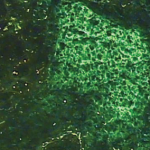Discussion
Sjögren’s syndrome is an autoimmune condition characterized by xerostomia, keratoconjunctivitis and secretary dysfunction of lacrimal and salivary glands. It is about 10 times more frequently diagnosed in women than in men.1 The average age of individuals with Sjögren’s syndrome is about 56 years old.8 Extraglandular manifestations include inflammatory arthritis, interstitial lung disease, tubulointerstitial nephritis, cutaneous lesions and blood dyscrasia. Laryngeal involvement of Sjögren’s syndrome is rarely reported and is less likely the initial manifestation of Sjögren’s syndrome.
Laryngeal involvement of autoimmune conditions includes tissue ulceration or granulation, edema, cricoarytenoid arthritis, vocal fold immobility and bamboo nodes in the vocal cords. Laryngeal involvement has been reported in systemic lupus erythematosus, rheumatoid arthritis, Hashimoto’s thyroiditis, Sjögren’s syndrome and mixed connective tissue disease.5 Initial manifestations in the majority of these cases include dysphonia, asthenia (i.e., abnormal physical weakness or lack of energy), dyspepsia and gastroesophageal reflux disease.
Most cases are treated with oral steroids, antacid and intralesional steroid injections. Oral steroids are the first-line treatment recommended by most experts, with speech therapy used as adjuvant therapy if needed.6 The most common DMARD used is methotrexate, in combination with oral and local steroids. In rare cases, endoscopic laryngeal surgery can be required after failure of oral and local steroid injections.
Conclusion
This case highlights the importance of evaluating connective tissue disorders in individuals who experience vocal fold mobility abnormalities. Although laryngeal involvement is not typical as an initial manifestation of connective tissue disorders, it can certainly be helpful with early diagnosis and a rheumatologic evaluation.
Although most other reported cases have used oral steroids and methotrexate for steroid-sparing effect, we chose hydroxychloroquine due to its minimal adverse effect profile in comparison with methotrexate and its known primary benefits in systemic lupus erythematosus and Sjögren’s syndrome. Other potential benefits to improved dysphonia include better control of salivary gland dysfunction using sialendoscopy.7
This case highlights the importance of evaluating connective tissue disorders in individuals who experience vocal fold mobility abnormalities. Although laryngeal involvement is not typical as an initial manifestation of connective tissue disorders, its presence should prompt a rheumatologic evaluation.
Mohammad A. Ursani, MD, RhMSUS, is a rheumatologist practicing in a multispecialty group in North Houston. He has clinical interests in systemic lupus erythematosus, Sjögren’s syndrome, musculoskeletal ultrasound.
Jaecel Shah, MD, is an otolaryngologist currently practicing in the North Houston area. His clinical interests include otolaryngological manifestations of connective tissue disease.
References
- de Paiva CS, Rocha EM. Sjögren’s syndrome: What and where are we looking for? Curr Opin Ophthalmol. 2015 Nov;26(6):517–525.
- Murube J. The first definition of Sjogren’s syndrome. Ocul Surf. 2010 Jul;8(3):101–110.
- Sjogren H. Keratoconjunctivitis sicca. In Trans Ophthalmol Section Swedish Med Association. 1929–1931. Acta Ophthalmol. 1932;10:403–409.
- Masarwa TO, Herold IH, Tabor M, Bouwman RA. Unilateral vocal cord paralysis following insertion of a supreme laryngeal mask in a patient with Sjogren’s syndrome. Case Rep Anesthesiol. 2016;2016:8185628.
- Todic J, Schweizer V, Leuchter I. Bamboo nodes of vocal folds: A description of 10 cases and review of the literature. Folia Phoniatr Logop. 2018;70(1):1–7.
- Ramos HV, Pillon J, Kosugi EM, et al: Laryngeal assessment in rheumatic disease patients. Braz J Otorhinolaryngol. 2005 Jul–Aug;71(4):499–503.
- Karagozoglu, Hakki, et al. Sialendoscopy enhances salivary gland function in Sjögren’s syndrome: A 6-month follow-up, randomised and controlled, single blind study. Ann Rheum Dis. 2018 Jul;77(7):1025–1031.
- Qin B, Wang J, Yang Z, et al. Epidemiology of primary Sjögren’s syndrome: A systematic review and meta-analysis. Ann Rheum Dis. 2015 Nov;74(11):1983–1989.

